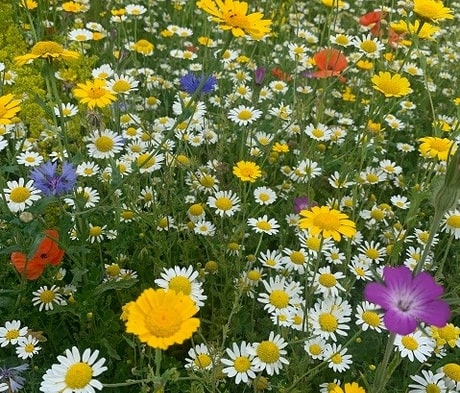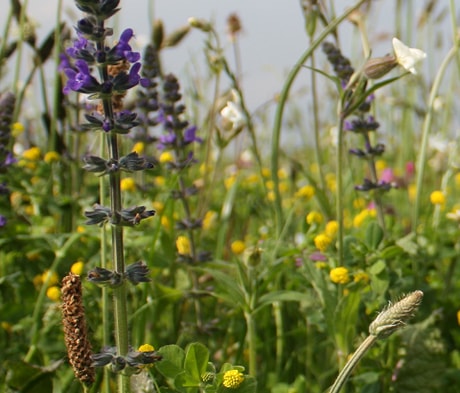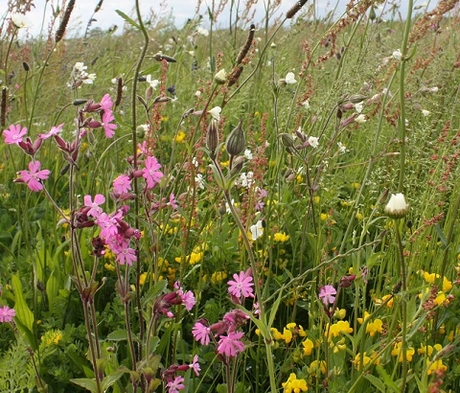There are a few types of wildflower meadow but we will focus on the easiest ones to get started in your own garden without being an expert.
It will take a little time, as our garden soil is often too rich for wildflower species, but if you start early it’ll be worth it.
Picking seed choice is important. Different mixes will need different soils, here we’ve tried to simplify it for you.
Annual seed mix
Annuals like cornfield annuals. They have vibrant colours and need richer soil to thrive. They will die back every year, so you need to re-seed in the spring.
So they are fairly well suited to private gardens, as there will most likely fertiliser in the ground. They make a beautiful display in that year.

Perennial meadow seed mix
These will flower every year – so they will be a permanent meadow that will be enjoyed for years.
Sometimes they take longer grow, so you will see more flowers in year 2 onwards. Don’t be disheartened when the first Summer looks a little weak.
These species prefer poor soil, so an abandoned patch or removing a lot of topsoil and waiting months will do this.

A mixture of the two
Often seed packets will also sometimes have both Annuals and Perennials in.
This means you get a big floral display year 1 from the annuals, then they die back. And then by year 2 the perennials really come into their own and bloom – then the perennials provide a permanent meadow.
It means you’ll get a fuller looking area faster.

With any seed mix, it’s absolutely recommended to pick native wildflower species to Britain – this is so important.
And it’s preferable to have the ‘perfect for pollinators’ label. You can also pick if you want 100% flower mix or some grasses too.
Time of year
The best time to start a meadow is in Autumn or Spring. This gives you time to prepare the soil ready for Summer flowering. If you’re sowing directly over grass – then Autumn is the best.
If you need to prepare the soil more heavily, then it may be worth starting early, please read on for when this is necessary.
Picking the area
You want to select a sunny spot that is fairly flat, not waterlogged or a well-trodden area.
Preferably you would pick a bare patch or create one, and with an annual mix, it can also be a border that maybe had compost in before.
It needn’t be a neat square!
In most cases, if possible, remove the top layer of turf before starting, it’ll usually have too much fertiliser in it and your seeds will be competing with the existing grass seed.
Weeding
Depending on the state of the soil, you want to remove any existing weeds. This might be easy, I did my chosen meadow patch in in 30 mins manually.
Plants like nettles, dandelions and docks may need a proper dig to get the full root out.
You can weed by hand, or if you plan in advance you can place a weed membrane (or cardboard) over the area for a few months, say over Winter when you’re not using the garden as much. (it’s also possible to use membrane over the grass to remove turf without digging)
Using membrane takes longer but is generally much easier going than manual weeding and is chemical-free.
Once it’s clear, rotavate or just loosen up the soil with a fork.
If you are dealing with a perennial only mix, you want to remove as much fertilised mud as possible, and leave it for some time, the mud wants to be considered ‘unproductive’ you don’t want any existing fertiliser at all there.
Sowing onto a lawn
Is it possible to sow on top of existing grass if too much digging is difficult for you, but it may be more sparse/ mixed results at first. It’s more of a long-term goal.
You’ll get best results if you have a mix with Yellow Rattle in (ours have this) as they will weaken the grass, allowing the flowers to grow.
It’s very possible though! And will be more successful If you plan in advance and want to wait a while, then stop fertilising it straight away, and start mowing once a week to weaken the existing grass. But if you don’t want to wait, you can just have a go.
Right before you sow the seeds mow it at short as possible.
When sowing, you want to try to get the seeds really in contact with the soil, between the grass shoots, if you mix it with sharp sand (4 part sand to 1 part seeds) it can help make it even and you can see where you missed. I’ve heard stamping on them after can help too!
It may take a few years to get an even balance of wildflowers and your own existing grass, but it doesn’t need much work. Just sit back mostly.
You’ll also see a number of the original flower species pop up that were already waiting for you to stop mowing, for example clovers, which bees love.
After you’ve sown, don’t mow at all! Just twice, in Late Summer and Early Spring.
If you don’t want to wait so long, you can try an annual mix that can thrive better in the rich soil. But results aren’t guaranteed either as they’ll still be competing with the grass seed for space.
Sowing seeds onto a prepared patch
On your bare patch, after the soil is prepared, the hard work is over! Just scatter the seeds down, try and do it in an even way. Again, if you mix it with sharp sand (4 part sand to 1 part seeds) it can help make it even and you can see where you missed.
Generally, most seed mixes will be 3-5g for 1m squared (but do check the label!) It’s often easy to underestimate what 1 m sqaured is, so it could be worth measuring the area.
Make sure the seeds have made good contact with the soil. Then water and wait. You don’t need to cover them over with soil, but they may need a little rake.
Maintenance
Wildflower maintenance is easy. No chemicals, no high maintenance.
You just want to weed any nettles or docks that spring up. They will relish in the chance to grow but aren’t very compatible.
Depending on the mix, the Annuals will come up in the Summer and give you great colour, but if you have a perennial seed mix, a few may wait until the next year to show themselves. So be patient.
You only need to mow or cut twice a year in early Spring and at the start of Autumn, please don’t mow April to mid-August. You also may find shears or a strimmer are the easiest for this job.
And importantly always make sure that you take away your cuttings afterwards. don’t leave anything on the ground, exposed soil is fine.
Share your results!
I hope you find this guide useful! We so look forward to seeing your wild spaces, please share your photos on Instagram by tagging us @giveitagrowwigan or using the hashtag #giveitagrow
3 Comments
-
[…] This is an easy and cheap one; if you have a patch you can leave to go a little wild (and beautiful), sowing a UK Native wildflower seed mix will do wonders and return year after year. We offer them our free in Spring and Autumn and have written about best practices and maintenance here. […]
-
[…] can read all about making a mini wildflower meadow at home and about the seeds we’ve […]

[…] I would always recommend using a UK native species. We have an in-depth guide to creating your own mini meadow at home […]